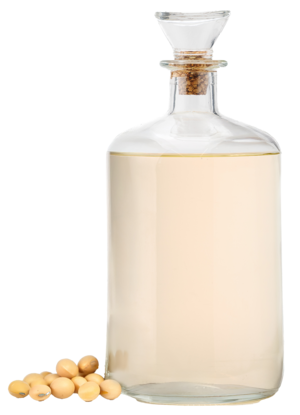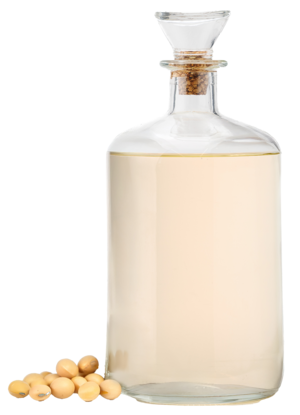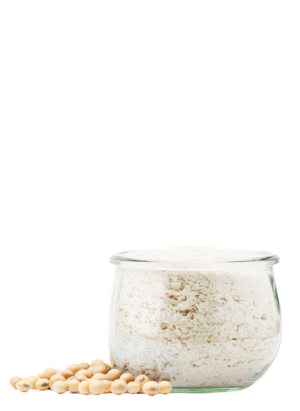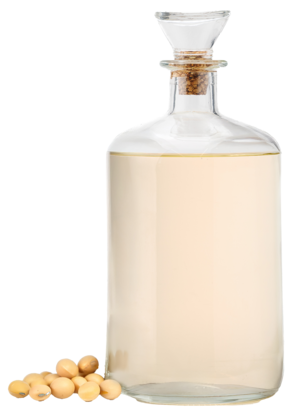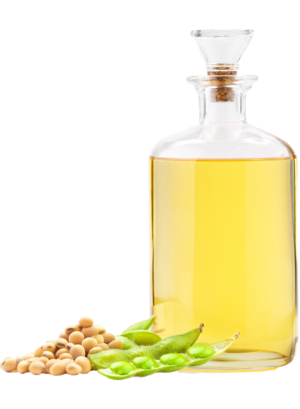Our Soybean oil qualities
We carry Soybean oil in the following qualities for you
Usage
|
Cosmetics |
Food |
Pharmaceutics |
|
|---|---|---|---|
| Soybean oil produced from GMOs refined Ph. Eur. | |||
| Soybean oil refined IP Ph. Eur. | |||
| Soybean oil hydrogenated Ph. Eur. | |||
| Organic soybean oil refined | |||
| Organic soybean oil cold pressed | |||
| Organic soybean oil refined Ph. Eur. |
Because of its amazingly diverse uses, including in modern food technology, soya is often referred to as "the miracle bean". Besides the main use of soybean oil in food, the pharmaceutical industry and cosmetics, the oil is also used in the technical industry for soap production and as stand oil for varnishes, oil paints, linoleum, printing inks and alkyd resins.

Soya plant & soybean
Soybean oil (also known as oleum soyae) is obtained as a co-product from the soybean. In the legume family (Leguminosae or Fabaceae), the soybean belongs to the subfamily of the papilionaceous plants (Faboideae). Due to its high protein content, the soya plant also belongs to the protein plants. The soybean is an annual herbaceous plant with brownish hairs. There are different varieties of the soya bean. High-growing varieties can reach a height of up to 2 meters. Most common, however, are upright growing varieties with a height of 20 to 80 centimeters. The green, thin stems are fine and densely haired. Soybeans have pronounced taproots up to 1.5 meters long. The soya plant lives in symbiosis with nitrogen-collecting nodule-bacteria that adhere to the roots of the plant. This is typical for the papilionaceous family. The term "nodule-bacteria" comes from the fact that the bacteria form small nodules on the roots. These are able to bind atmospheric nitrogen and make it available to the plant by converting it into high-quality protein. This favourable characteristic means that there is no need for artificial nitrogen fertilization of soya fields.
The green leaves are three to five in number with ovoid leaflets. They are also hairy on the edge and on the underside. Even as the soybeans ripen, the plant shed its leaves. The flowers of the soya plant are short-stalked, white or purple, self-pollinating and can be seen for about 3 to 4 weeks. It takes about five months from sowing to harvest. As fruits, the plant forms 3 - 5 cm long, brown-yellow hairy pods with usually 2 - 3 internal beans. Depending on the variety, these are white, yellow, green, brown or purple to black. The different varieties are distinguished by their level of ripeness, sizes, types, colours, oil content and intended use. Yellow seed kernels are used in oil production. Still unripe, green or yellow seed kernels are consumed as vegetables. Brown and black seeds are often used as animal feed. Soybean fields are brown and bare when harvested, because towards the end of the growing season the leaves of the plant wilt and fall off before the beans are ripe. The seeds contained in the pods have a protein content of between 35% and 50%, making them the grain fruits with the highest protein content. The oil content of the beans ranges between 15 and 21%.
The soya bean (Glycine max) is a subtropical plant but is now also cultivated in tropical climates and regions with a moderate climate. The plant therefore thrives best at high temperatures and, especially in the beginning, with plenty of water.
Would you like to be informed about the general market situation of Soybean oil and our other products?
subscribe to market reportCultivation & yield
Soya is one of the most widespread agricultural crops in tropical countries. Nevertheless, North and South America are leaders in both the production and export of soybeans. The second most important soybean producers and exporters are Brazil and Argentina. The most outstanding importer of soybeans or direct soybean meal is the EU. This is mainly to cover the demand for animal feed. Approximately 3.0% of the global harvest is produced in Europe.
The thousand grain mass ranges from 50 - 450 grams. The soybeans can be harvested fully automatically by combine harvesters. The harvest time is September/October in the northern hemisphere and February/March in the southern hemisphere. Soya is the economically most important seed oil plant in the world - also in terms of the area under cultivation. Soybean oil is the most produced vegetable oil in world oil production, after palm oil and before rapeseed oil, with a share of over 30%.
The global annual production of soya was approximately 348,712,300 tons in 2018.

Background / history
The original soya bean is derived from the wild form Glycine soya and comes from Asia. The oldest evidence of human use of non-domesticated soya seeds comes from northern China (7,000 BC) and Japan (5,000 BC). In medical texts from China soy was first mentioned about 6,000 years ago. In 2,853 BC, the ruler Sheng-Nung of China proclaimed the soybean to be one of five sacred grains (in addition to millet, wheat, beans and rice). Between the 1st century and the year 1,100, soy was also exported to neighboring countries such as Burma, Japan, India, Indonesia, Malaysia, Nepal, Thailand, the Philippines and Vietnam. For the people of China, Japan, Korea, Indonesia and the Philippines, soy has been one of the most important foods for several centuries, alongside meat, milk, bread and oil. This also explains why soy is often called "gold out of the ground". Alternatively, the soya bean has also been called the "golden bean" and also the "miracle fruit". Engelbert Kaempfer discovered the soya bean for Europe, he first described it after his trip to Japan in 1691/92. There is first evidence from 1737 that the soya bean was grown in botanical gardens in Holland, and in France in 1739. In Europe, however, the cultivation never gained any importance. Samuel Bowen first brought the soybean to the USA in 1765. Until the beginning of the 20th century, soya remained virtually unknown outside its Asian homeland. It was only after World War II that the plant was spread in North and South America.
25,000
kg
Tank truck
900
kg
IBC
190
kg
Drum
27
kg
Canister
General durability: canister 12 months, drum 18 months, IBC 6 months
Nutritional values & composition
| Nutritional value | (per 100g) |
| Energy | 3,700 kJ / 900 kcal |
| Fat | 100 g |
| Saturated fatty acids | 15 g |
| Monounsaturated fatty acids | 26 g |
| Polyunsaturated fatty acids | 59 g |
Fatty acids ratio
Composition
| C16:0 Palmitic acid | 9 – 13 % |
| C18:1 Oleic acid | 17 – 30 % |
| C18:2 Linoleic acid | 48 – 58 % |
| C18:3 Linolenic acid | 5 – 11 % |
You want to buy Soybean oil?
Request now free of charge and without obligation from Gustav Heess. We deliver Soybean oil ...
- worldwide
- fast
- reliable
We offer Soybean oil in the following packaging units:
-
25,000
kg
Tank truck -
900
kg
IBC -
190
kg
Drum -
27
kg
Canister
